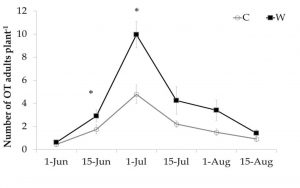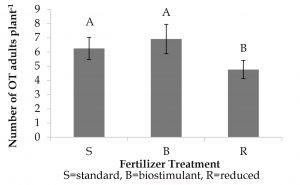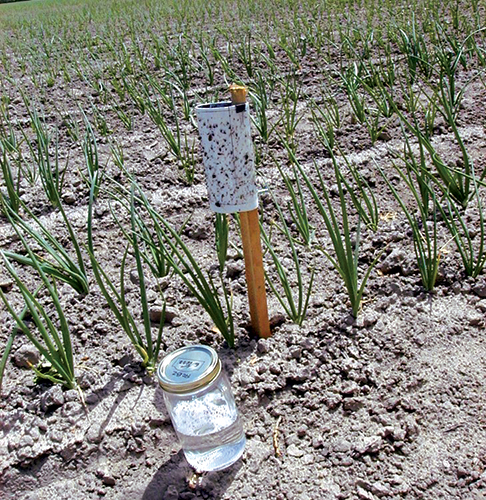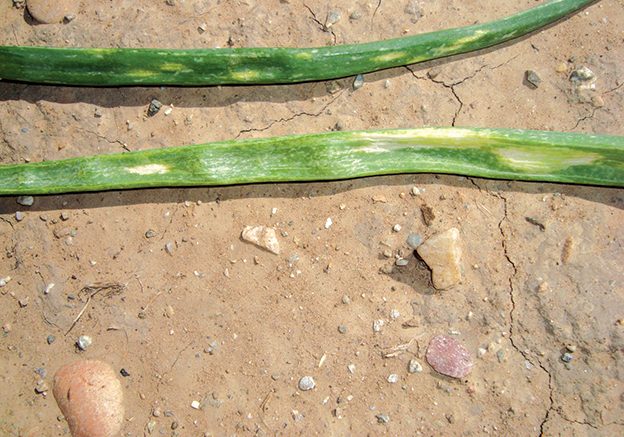By Kristie Buckland, Vegetable and Specialty Seed Crop Extension Specialist, Oregon State University
With the constant threat of thrips in onion production and the increasing challenge of managing the pest, researchers continue to look toward whole-farm management strategies to reduce onion thrips populations.
Onion thrips are one of the biggest pest problems in onion production. Feeding damage from onion thrips can reduce yields considerably. Also, Iris Yellow Spot Virus (IYSV) can be transmitted by onion thrips, resulting in devastating losses. Growers frequently rely on insecticide sprays as often as every seven to 10 days to suppress thrips. Reports of insecticide resistance have increased in the last decade, making effective control even more challenging. There is a need for alternative methods to control onion thrips.
Two research projects at Utah State University in 2009 and 2010 were conducted to examine the potential for changes in farm management practices to reduce thrips and IYSV disease pressure.

Figure 1. Number of adult onion thrips (OT) per plant in 2009 following corn (C) or wheat (W) the prior year
Crop Rotation, Nitrogen Application
The first study looked at the effects of prior crop rotation and applied nitrogen fertilizer on the number of onion thrips and IYSV incidence. In the year prior to onions, fields were planted to either wheat or corn with no fertilizer or insecticide applications. During onion production, there were three nitrogen (N) fertility treatments tested. The first treatment had a total of 400 pounds N/acre; the second treatment totaled 135 pounds N/acre; the third also had 135 pounds N/acre and also included a soil bio-stimulant product. Fertilizer treatments were split at fall, spring pre-plant, June and July dates to provide readily available N during rapid onion growth.
Although there were large differences in applied N, there were no yield differences between fertilizer treatments or prior crop rotation. Neither total yield nor size category of onions were different among treatments. There was also no difference in disease incidence, although overall disease pressure was low both years.
However, there was a difference in the number of thrips per plant and available soil N. There were more thrips on onions planted after wheat than after corn (Fig. 1); there was also more N in the soil after wheat than corn. Onions with the highest N fertilizer rate and the bio-stimulant treatment had more thrips than onions with the reduced rate of N alone (Fig. 2). Soil N was higher with high fertilizer rates than both of the reduced fertilizer rates.

Figure 2. Number of adult onion thrips (OT) per plant in standard, bio-stimulant and reduced fertilizer rates
The results of this first study suggest that prior crop rotation can have a dramatic effect on onion thrips populations and soil N. Plots that had more applied N also had more adult thrips. Since there was no difference in yields observed, a reduction in applied N fertilizer seems a reasonable approach to reduce thrips without negative effects on plant growth. These results suggest that it is possible to reduce onion thrips populations by changing crop rotations and available soil nitrogen.
Trap Crops
The second field study was an exploratory study attempting to identify plants that might be used as a trap crop for onion thrips in onions. Trap crops have been used in many cropping systems to provide either a “push” or “pull” type of effect on invading pests. In this project, the selected trap crops were intended to provide a highly attractive alternative food source to invading adult thrips, thereby diverting thrips away from onions. Ideally, these trap crops could provide enough of a “pull” to concentrate thrips within the trap crops, avoiding damage to onions. The trap crops could then be treated to control thrips, saving time and money with a smaller area of application.
Carrot and buckwheat were selected for trap crops because of their potential to provide a secondary crop that could also be harvested. The third crop was lacey phacelia, a quick-growing, highly attractive flowering plant frequently used to attract insects. Trap crops were planted in 15-foot long sections within a single bed of a commercial onion field. Onion thrips populations were measured within trap crops and in onions up to 40 feet away from the trap crop plantings.
The results of trap crop plantings on onion thrips populations were mixed. Early in the season when onions were small, lacey phacelia was large and attractive to thrips. However, lacey phacelia bloomed and senesced by early July, before the peak of onion thrips populations. Buckwheat and carrot grew more slowly early in the spring, but were present during the full onion production season. Buckwheat was attractive to thrips later, around July, when it was large and in bloom. Carrot did not appear to pull significant numbers of thrips away from nearby onions.
Trap crops did not significantly reduce onion thrips populations at distances farther than about 3 feet from the trap plots. The effects of an attractive trap crop were limited to a small area when planted in the middle of an onion field as in this study. However, trap crops planted along field edges may be more effective. There were also slightly higher rates of IYSV detected on onions closer to trap crops. This might mean that thrips tended to stay within trap crops once pulled away from the onions.
The trap crop study demonstrates a few keys concepts that need further investigation. First, trap crops could be effective to divert thrips away from onions, but the range of “pull” is limited. A trap crop planting along the field edges might be more effective in containing onion thrips as they invade the field and would likely be easier to manage throughout the season. Second, trap crops are complex to manage for proper timing of plant life cycles. The growth of both onions and trap crops need to be planned to provide a full season of attractive alternative crops. It may be more feasible to use multiple trap crop species such as a mixture of lacey phacelia for early season flowering inter-seeded with buckwheat for mid- to late-season flowering.

Researchers monitor onion thrips populations with white sticky traps within onion rows and by washing thrips off onion leaves in soapy water. Photo by Diane Alston
Research Conclusions
Overall, these studies could provide some promising strategies to decrease thrips incidence and reduce insecticide use. Changing crop rotations and reducing nitrogen inputs seems likely to reduce onion thrips while maintaining yields. Also, using a trap crop to divert onion thrips from onions has potential but needs further refining in field trials to fine-tune trap crop location and timing.
These projects were funded through a Western SARE grant through Utah State University and involved Kristie Buckland, Jennifer Reeve, Dan Drost, Diane Alston and Claudia Nischwitz.


